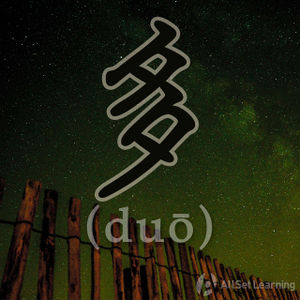Difference between revisions of "Doing something more with "duo""
| Line 1: | Line 1: | ||
{{Grammar Box}} | {{Grammar Box}} | ||
| − | In China, you often | + | In China, you often hear you should do this or that more (eat more, drink more water, wear more warm clothing etc.), and they often use the word 多 (duō). What's not intuitive to learners is that the word 多 should come ''before the verb''. |
== Structure == | == Structure == | ||
| − | + | This structure is often used in commands or suggestions. Note the position of 多: | |
<div class="jiegou"> | <div class="jiegou"> | ||
| − | + | 多 + Verb + Object | |
</div> | </div> | ||
| − | + | This structure is not used exclusively as a command, so you could also include a subject if you needed to. | |
== Examples == | == Examples == | ||
| Line 25: | Line 25: | ||
</div> | </div> | ||
| − | + | == Counter-Examples == | |
| + | Just to be completely clear, the following uses of 多 are not as natural as the ones above. | ||
| + | |||
| + | <div class="liju"> | ||
| + | |||
| + | <li class="q">吃 <em>多</em> 点。</li> | ||
| + | <li class="q">喝 很 <em>多</em> 啤酒 吧!</li> | ||
| + | <li class="q">我 应该 运动 <em>多</em> 点。</li> | ||
| + | |||
| + | </div> | ||
| + | |||
| + | The opposite of 多 is, of course, 少. It is further explained in the article [[Doing something less with "shao"]]. | ||
==See also== | ==See also== | ||
Revision as of 01:54, 3 May 2013
-
Level
-
Similar to
-
Used for
-
Keywords
In China, you often hear you should do this or that more (eat more, drink more water, wear more warm clothing etc.), and they often use the word 多 (duō). What's not intuitive to learners is that the word 多 should come before the verb.
Contents
Structure
This structure is often used in commands or suggestions. Note the position of 多:
多 + Verb + Object
This structure is not used exclusively as a command, so you could also include a subject if you needed to.
Examples
- 多 吃 点。
- 多 喝 啤酒 吧!
- 我 应该 多 运动。
Counter-Examples
Just to be completely clear, the following uses of 多 are not as natural as the ones above.
The opposite of 多 is, of course, 少. It is further explained in the article Doing something less with "shao".
See also
Sources and further reading
Books
- Integrated Chinese: Level 1, Part 2 (pp. 39) →buy
- 发展汉语 中级汉语口语上 (pp. 72)



